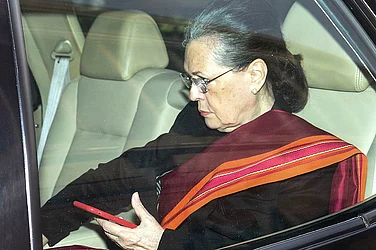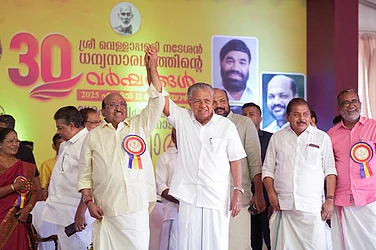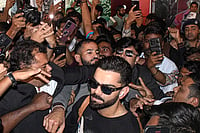It’s like a dam had burst: as if a reservoir of anger filling up silently had suddenly breached its bounds. The unrest unleashed across India over the Citizenship (Amendment) Act, 2019, was on a scale and of an intensity the Narendra Modi government probably did not anticipate. The prime minister and home minister Amit Shah—forced to come out and defend the act—reiterated that it’s not meant to “take away the citizenship of any Indian”. But the zones of agreement seemed to be shrinking all around. The world media focused unflattering attention, allies dithered or issued caveats, former allies outed caustic taunts, the Opposition did what the Opposition does…but the real sounds came from the streets. They were resounding with something close to a popular veto. It had spilled far beyond the usual enclaves of dissent: city after city saw rallies, and protest calendars filled social media. Young, articulate voices spoke their mind to TV cameras and even IITs, IIMs and private universities joined others in expressing solidarity as a much-videographed police crackdown turned some campuses into warzones.
The students of Jamia Millia Islamia became the face of the anti-CAA protest, offering some iconic visuals and soundbytes amid lathicharges and tear-gas fumes. Also Aligarh Muslim University (AMU). As police action produced stories of severed limbs and lost eyes, it’s the cops who ended up being widely accused of firing on students, arson, vandalism and bias. With two minority education institutions in focus, whether polarisation was part of the ruling BJP’s plan or not, some debate turned around to whether this was only a ‘Muslim protest’. But one salutary aspect to it was a strong pushback by students, civil society activists and even politicians all around to that idea. The anti-CAA mood seems to have created solidarity among students and citizenry, cutting across region and religion, providing them with an outlet to express their accumulated grievances against the government.

The Supreme Court, meanwhile, is hearing 59 petitions challenging the constitutional validity of the act. A three-judge bench headed by Chief Justice S.A. Bobde has issued notice to the Centre and fixed January 22 as the next date of hearing. The petitioners include the Asom Gana Parishad (AGP), a key ally of the BJP in Assam, now threatening to withdraw support. Protests continue in Assam to protect their ‘jati, mati and bheti’ (community, land and base). Other allies have expressed reservations too: Akali Dal leader Sukhbir Singh Badal has asked the government to take a relook at CAA. Naresh Gujral, senior Akali leader, says the entire country must be taken along in matters like this.
“We are a minority party and there’s a feeling that all minorities should feel secure in this country,” he says. There’s unease within the JD(U) as well: leaders like Pawan Verma and Prashant Kishor have openly expressed their dissent over Nitish Kumar’s support to CAA. Verma says he is contemplating his future in the party.

Maharashtra CM Uddhav Thackeray, an ally till the other day and still a Hindutva voice, warned the Centre against the ‘Yuva bomb’ and likened Jamia to Jallianwala Bagh. DMK leader M.K. Stalin led protests across Tamil Nadu, even as the BJP regime in Karnataka clamped Section 144 to prevent rallies. No such curbs in Kerala, which saw a rare show of camaraderie between bitter political foes—CM Pinarayi Vijayan and leader of opposition in the assembly Ramesh Chennithala came together in a joint protest to condemn the “unconstitutional and autocratic act”.
In West Bengal, the one state besides Assam where anti-immigrant politics will have a direct effect, CM Mamata Banerjee was out on streets, at the head of a massive rally, making it clear that she will not allow the divisive act or the National Register of Citizens (NRC) to be implemented in her state. The government’s plans to implement NRC—originally meant to identify ‘illegal immigrants’ in Assam—all over India is what has lent a hard edge to the citizenship law. But emboldened by the mass outrage, Mamata has dared the Centre to topple her government, even send her to jail. Her protestations are grounded in realpolitik: assembly elections are due in 2021, and the BJP’s aggressive push in Bengal banks on this issue. Historian Mridula Mukherjee says the strategy is to polarise. “Politics is very volatile in Bengal. Some districts have 30-35 per cent Muslim population…the BJP may try and incite violence and thus communalise the middle class,” she says.

UP Police taking away an AMU student during protests against CAA.
At the political level, things seemed headed for a confrontation between pro- and anti-CAA camps in Bengal. Governor Jagdeep Dhankhar also swam into the debate, with tweets criticising the state administration’s failure on ‘law and order’. Mamata, in turn, shot off a stern letter reminding him of his constitutional obligation to support the state government in the effort rather than aggravating the situation by provoking elements who might attempt to disturb communal peace. In almost all districts, political parties and civil society activists have started mobilising against CAA.
The BJP too is planning a series of rallies, in support of CAA, confirms state party president Dilip Ghosh. It has already started a door-to-door campaign among Hindu refugees, highlighting the positives of CAA. The divisions, clearly communal, are finding expression on social media too—in Bengal and elsewhere.
The air of rancour comes at a cost, though. PM Modi’s well-cultivated global image has come under some stress: the biggest immediate fallout was the cancellation of Japanese PM Shinzo Abe’s visit, meant to be replete with symbolism as it was anchored in the Northeast. Coming close on the heels of Article 370, the government is also expecting a backlash from the West—worrying if Islamic countries find a common cause with the liberal West on global platforms. The government is also struggling to disassociate the current friendly regimes in Afghanistan and Bangladesh from the charge of religious persecution implied under CAA. Yet with the Sheikh Hasina government also deferring state visits, India clearly needs a massive diplomatic effort to limit the damage.
To an extent, in a world filled with issues relating to migrants, India’s actions are fairly transparent. “CAA/NRC are pieces of a larger puzzle that aims at recasting the terms upon which the Indian republic was founded,” says Gilles Verniers, assistant professor of political science at Ashoka University. “The BJP is seeking to transform the nature of the republic not in one stroke, by changing the Constitution, but more covertly, with ‘reforms’ it can defend under the guise of common sense.... Who does not want to see persecuted minorities protected? On its own, CAA is more symbolic in the sense that it does not immediately affect Indian citizens. But combined with NRC, it becomes a powerful weapon to disenfranchise Muslims and maintain them in a state of precariousness.”
Somewhat stumped by the intensity of protests, the BJP is trying to tone down its NRC rhetoric, at least for now. Shah had ratcheted up the talk during the recent poll campaign: then, or during the Parliament debate, he had made no secret of the fact that CAA and NRC are linked. However, the present recalibration in no way means the BJP has given up on NRC: it’s a temporary tactical retreat. Party leaders are convinced the anti-CAA mobilisation won’t last long.

A Sabarimala pilgrim joins a protest march against CAA in Kerala.
Political scientist Suhas Palshikar thinks the BJP knew it was a calculated risk, combining electoral calculations with its ideological agenda. “It has nothing to do with religious persecution. The objective is clearly Hindu-Muslim polarisation all over the country, which benefits the BJP politically,” he tells Outlook. “The government also thinks that if Muslims come together, they are not likely to rally behind the Congress.”
BJP vice president Avinash Rai Khanna is disappointed when he hears this argument. He has been fighting for the cause of Hindu refugees from Pakistan for over a decade—consistently raising questions as Rajya Sabha MP earlier and helping them on the ground. “We did not start this fight today. Parties like the NC, the PDP and the Congress have behaved irresponsibly towards the thousands of refugees from West Pakistan,” he says. “They were not even given the status of state subjects in J&K, till after Article 370 was removed.”
Khanna says the issue is humanitarian. “These people have been living in fear, without basic rights, for a long time. They have waited patiently to become citizens of India.” For Assam, he concedes some changes may be made if required—“The home minister is open to all suggestions.”
Palshikar too feels the government may make some concessions for Assam—maybe introduce an Inner Line Permit (ILP) type mechanism—since it cannot afford to antagonise the state it won with great effort and difficulty. Political analyst Manisha Priyam says the government should have had the foresight to hold pre-legislation deliberations with its allies in the Northeast at least. “Laws can have unanticipated consequences. In this case, the unintended consequences overwhelmed the law,” she says. Even in other ways, Priyam equates the act to demonetisation—shaking the fabric of governance because of being done without much thought. “CAA attacks the very sense of belongingness evoked by the first words of the Preamble—‘We the People of India’. Ours is a country built out of the struggles of ordinary people. The government cannot ignore this unrest,” she adds. CPI general secretary D. Raja too says the unrest is a sign that India’s democracy is still alive and kicking. “By scrapping Article 370, they destabilised Kashmir. Now, the Northeast and other parts are also in turmoil. But I am hopeful seeing the resistance all around,” he says.
Senior Congress leader Salman Khurshid, however, feels the BJP government was unable to sell the CAA narrative unlike with triple talaq and Article 370. “The Northeast rejects it completely. And the reactions are coming from across the religious divide. There is a lot of disquiet, because CAA is incompatible with our constitutional commitments. Religion is never taken into account for the purpose of deciding people’s entitlements, except to the extent of providing minorities special protection,” he says. But the Congress, as the main opposition party, may be treading a tad cautiously: it says it doesn’t want to be seen as politicising the issue for electoral gains. “This is the moment to restore sanity and peace,” says party spokesperson Sanjay Jha.
That’s what gives this the classic hue of a ‘leaderless’ protest led by the citizenry itself. “This time, the opposition is not from political parties. It is a civil society opposition. The parties are secondary to civil society now,” says sociologist Shiv Visvanathan. “Whether it’s Priyanka Gandhi or Sitaram Yechury, they were very casual in their opposition. It’s like they are attending a picnic. This is where I congratulate the younger students who are taking a stand.”
Palshikar believes students have found an outlet in CAA to express their pent-up frustrations. “Apart from CAA, the youngsters cannot ignore the history of the government. They see the government spin in what happened in JNU and Allahabad University as anti-student. It also reflects their uncertainty about the future given the state of economy and employment. Historically, all over the world, whenever there are protests, students are attracted to them because they have less stake in the present, but more in the future,” he adds. That by itself becomes a mechanism for hope. “The BJP can roadroll majoritarianism, but once the seed of doubts are sown, the opposition starts to grow on its own and acquires a dynamic. So far, everyone was calling the BJP a juggernaut. I think the juggernaut just slipped over a few banana peels,” says Visvanathan.
By Bhavna Vij-Aurora and Preetha Nair With Rajat Roy in Calcutta


























